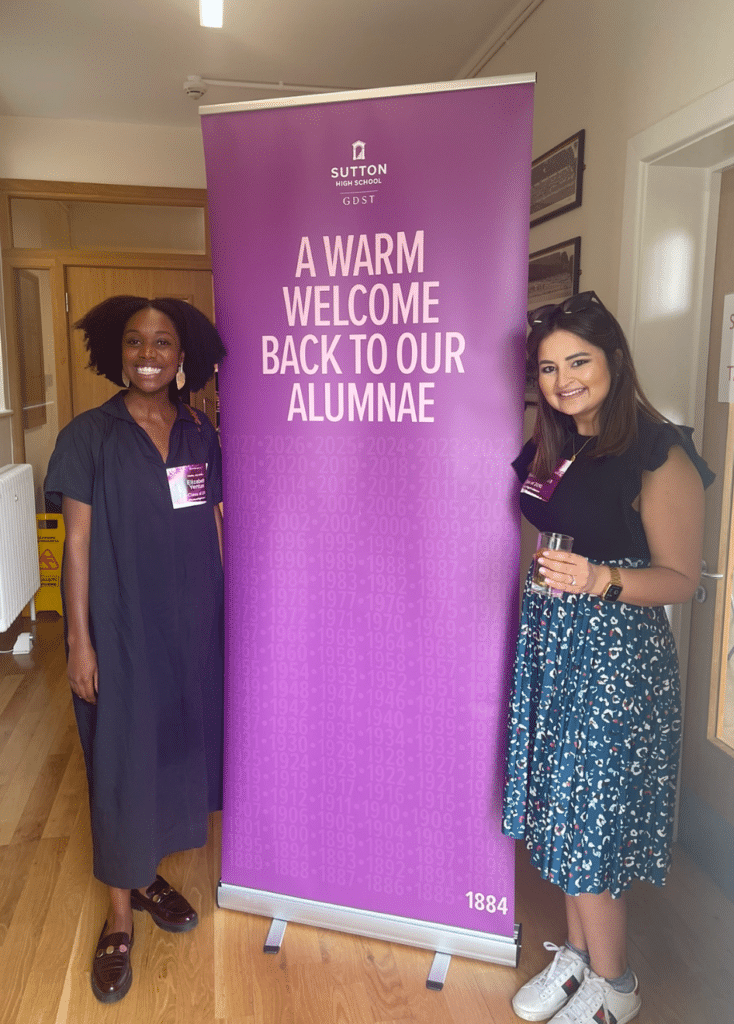21 June 2023
A hearty congratulations to the GDST’s 2023 Space Technology Diploma cohort of twenty-seven students across eight GDST schools! Within this year’s cohort, two Sutton High School students, Priya C and Farah R, have defended their coding portfolios and received their diploma certificates. In order to complete the diploma credential, candidate students travelled into central London for the end of year diploma student conference and took part in a live coding task, focused on the Royal Foundation’s Earthshot Prize theme and applying NASA Earth satellite data sets to AI machine learning algorithms.
Their goal was to predict satellite data correlations that may work toward monitoring one of the five target environmental ‘Earthshots’. The coding tasks were carried out by mixed GDST-school groups at Amazon Web Services (AWS) Headquarters in central London, under the guidance support of Sutton High School Space Technology Diploma Alumni mentors Kiyara Wijeratne and Sophie Streater. Each student group then delivered their completed task viva presentations to a virtual, international evaluation panel of space industry professionals, following inspirational talks by CranSEDS President Sara Alão of Cranfield University, AWS Geospatial Engineering Lead Phil Cooper and University of Warwick Satellite Team (WUSAT) Director Dr Bill Crofts, who also finally presented the students with their diploma certificates. Special awards were also given by the panel toward the end of the day, one of which was received by our Sutton High School Royal Society STEM Partnership Grant Project team, Kiyara Wijeratne, Sophie Streater, Priya Chaudhuri and Farah Rizwan, whose work was presented to the panel in relation to its integrated use of our new student cloud-computing Proof of Concept (PoC) facility sponsored by AWS this year.
As host school of the GDST-wide programme, Sutton High School would like to express their sincerest gratitude to each of the knowledgeable panelists in virtual attendance for the afternoon, Elizabeth Joyner of NASA Earth Science Data Systems, Angela Rizzi and Desiray Wilson of My NASA Data, Iksha Gurung, Muthukumaran R, Dr Manil Maskey and Dr Jennifer Wei of NASA-IMPACT, Dr Czajkowski Kevin of University of Toledo leading for GLOBE Mission EARTH, Dr Brad Hegyi of NASA POWER, Dr James Acker of NASA GES DISC, Lauren Childs-Gleason and Kenton Ross of NASA DEVELOP, and Mark Chang of Capgemini Invent.
A special thank you also to guest industry engineer speakers Dr Haleh Safavi and Victoria Wu of NASA Goddard Space Flight Center, who offered a superbly informative and insightful talk on some of the latest NASA technology developments for our students considering future careers in Space Technology. The students could not have wanted for more passionate and enthusiastic role models during their landmark day! The diploma conference event followed an opportune discussion between GDST Space Technology Diploma Lead Nicola Jane Buttigieg and Dr Paul Bate, CEO of the UK Space Agency at the UKSA Ignite Space conference earlier this year, after which Dr Bate announced his timely launch of the UK’s ‘Space to Learn’ scheme, which has just channelled £4.3 million into UK space education projects. The scheme hopes to offer a firm boost to upskilling initiatives inclusive of computer programming for the UK space industry, an area our GDST diploma also strives to promote and support as an educational institution providing for female pre-university STEM students.
What is the A level extension Space Technology Diploma?
The GDST Space Technology Diploma is an advanced, A Level computer science curriculum extension offering for GDST school students with GCSE Computer Science Python Programming ability (or equivalent). Further information is available from the Sutton High School Computer Science department, and the programme will also be promoted at the school’s Open Evening event this week.
What do students study on the Space Technology Diploma?
A notable requirement of the GDST Space Technology Diploma is each individual student’s Python programming portfolio. The student portfolio evidences their practical work delivered during the course of the year and is evaluated by a guest panel, in conjunction with a live practical task and viva assessment. The guest panel is made up of space industry professionals, who at different stages during the year have typically delivered resources or online presentations to the diploma cohort. The portfolio document also aims to double as an interview tool, presenting skills developed during the scope of the programme, and containing samples of tutorial codes, visualisations and data interpretive explanations by the student.
What do Space Technology Diploma portfolio tasks entail?
Prescribed portfolio tasks cover project briefs such as remote data collection and transmission, predictive processing and visualisation of remote data, physical computing sensor robotics, computer vision, reduced deep space 2D array image and telemetry generation, and airborne device design simulations. Students opting for the distinction level certificate also have the opportunity to present an innovative new software pitch for space technology.
Supporting guest speakers participating in lectures to date have visited from institutions such as the US Naval Academy and NASA Goddard Space Flight Center, and have addressed topics such as integrated use of flat patch antenna propagation, avionics PID loop control engineering, quadratic models for regression charts, asynchronous communication in embedded systems, reaction wheels and Nadir sensing for orbiting satellites, ‘shake and bake’ payload rocket-vibrational analysis and coded ‘balloon marching’ for accurate HAB launching, rupture and landing location, to name a few.


